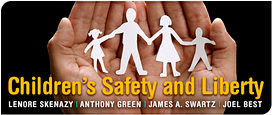Lead Essay
Lenore Skenazy argues that when it comes to children, we have gone too far in the pursuit of safety at all costs. This isn’t just a cultural phenomenon, either; it has serious implications for public policy, in the form of consumer product regulations and family and even criminal law. She suggests that it’s time to start learning to relax about children’s safety. In particular, allowing kids to take controlled risks is one of the ways that we introduce them to the real world, which is not and should not be risk-free.
Response Essays
Anthony Green argues that child safety is nothing to joke about. It is not an overreach to call the police if you see a child alone in a locked car; on the contrary, you should certainly do it. Real progress has been made in child safety in recent years, even as new threats emerge, including toppling television sets and poisoning among older children. The child protection community has done tremendous good, and safety enables fun rather than inhibiting it.
James A. Swartz argues that the multibillion dollar corporations that make children’s products have a responsibility to deliver them without any safety hazards. Recalls and labeling are not enough, and a close examination of many such cases reveals a disturbing trend: Corporations are often indifferent to children’s safety. We ought not to excuse or make light of such behavior.
Joel Best identifies two changing factors in American culture that have contributed to overblown fears related to children. The first is the mass media, which excels at spreading alarming stories, whether true or fictionalized. The second is the declining birthrate, coupled with increased safety itself: There are fewer children per family, and losing one is not an experience we suffer so often nowadays. As a result, smaller problems appear more alarming.
The Conversation
Letters to the Editor
Related at Cato
- Event: Reining in the Nanny State with Michelle Minton, Senior Policy Analyst, Competitive Enterprise Institute; Julie Gunlock, Senior Fellow, Independent Women’s Forum; Mike Riggs, Associate Editor, Reason Magazine; Walter Olson, Senior Fellow, Cato Institute; moderated by Caleb Brown, Director of Multimedia, Cato Institute. February 6, 2012
- Blog post: Buckyballs, the CPSC, and the Coconut Menace by Walter Olson, October 17, 2012
- Blog post: The Risks of Playground Safety by Walter Olson, July 20, 2011
- Blog post: 100,000+ Cribs May Be Headed for Dumpsters Today by Walter Olson, June 28, 2011

